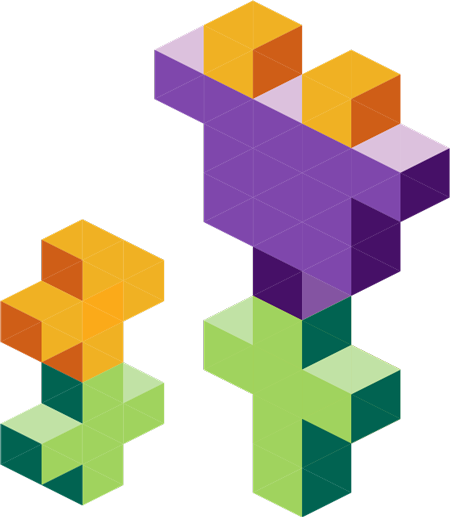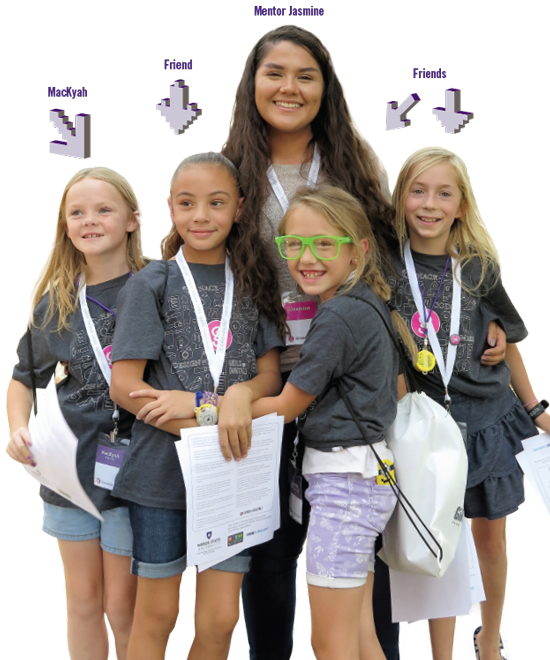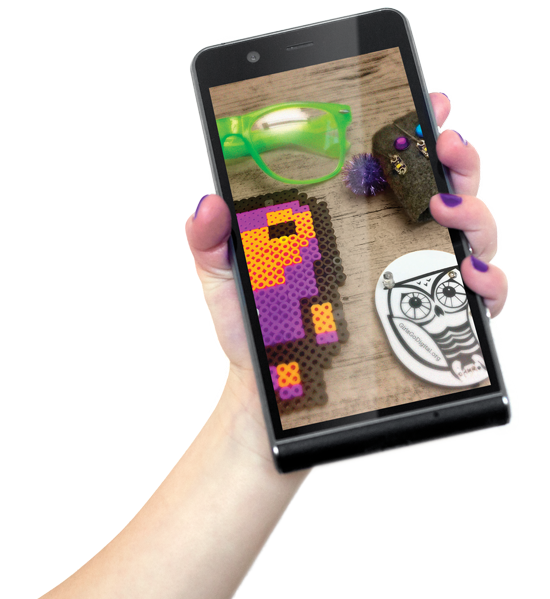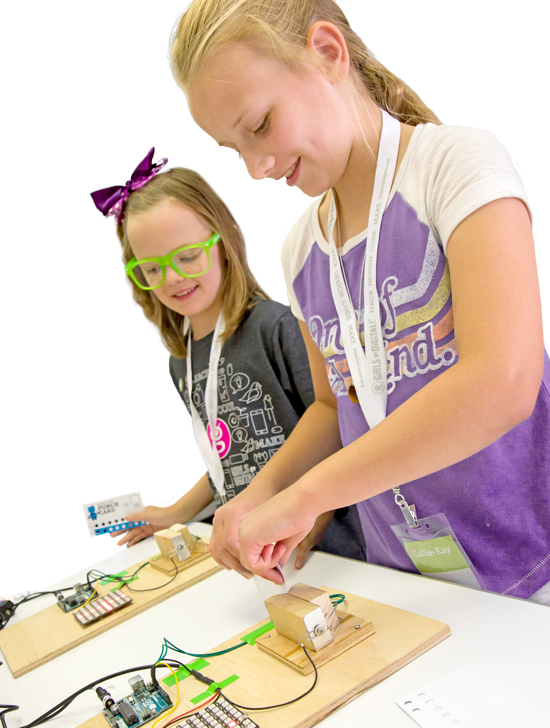Planting Digital Roots
Amy Renner Hendricks MARKETING & COMMUNICATIONS

MacKyah Tuck wriggles excitedly in her chair in a third-floor office in Weber State University’s Elizabeth Hall. Four items are displayed in front of her: a felt bracelet, a lightup owl magnet, a piece of pixel art and a pair of lime-green glasses. The bracelet is her favorite. MacKyah picks it up, pushes a button on the back, and LED lights flash on, illuminating the colorful jewels and “fuzz balls” she used to make it sparkle. She sits up on her knees and scoots closer to the edge of her chair to demonstrate how it works. “See this gray thread? It’s electronic. We had to do the order of the thread just right and make sure it wasn’t showing in the front, or only a little bit in the front. Then we had to make sure the thread would connect to the right hole to make it light up,” she says, flipping the bracelet over to show off the circuitry and stitchery.
MacKyah goes on to demonstrate the magnet — “We used a soldering tool and made these little Hershey kiss shapes with the solder (to join the metals on the back),” she explains — the pixel art, which is patterned after Iron Man — “He isn’t my favorite superhero, though; The Flash is,” she exclaims — and the glasses — “They help me see to code,” she reveals. She also talks about motherboards, HTML, web design, stop-motion video and robots.
Incredibly, MacKyah is just 9 years old and in the fourth grade. She has big gray eyes, a spattering of freckles across her nose and is wearing kneehigh sneakers with bright purple laces (purple for Weber State, of course) and her 2017 Girls Go Digital shirt. Girls Go Digital is where she learned to be so technologically minded. It’s her favorite summertime activity for a couple of reasons: “It helps me learn a lot of stuff about technology. It’s really fun. You get to make stuff to show your parents. It gets me out of the house during the summer. You get to meet new friends from other schools,” she says.
 Ok, that’s a lot of reasons, but it’s a can’t-miss program for MacKyah and for a number of other local girls, ages 8 to 18.
Ok, that’s a lot of reasons, but it’s a can’t-miss program for MacKyah and for a number of other local girls, ages 8 to 18.
Girl Power
Girls Go Digital provides opportunities for girls to learn about computers, programming, technology and design. Dixie State University hosted the first Girls Go Digital camp in 2013, with six girls in attendance. By 2016, the program had expanded to six universities across Utah, with 450 participants total. The projects teach four main skills — “HACK,” “CODE,” “DESIGN” and “MAKE” — and are selected and designed by girls for girls. The workshops are presented by women who support girls’ engagement in computer science and technology.
2017 was the second year WSU hosted a Girls Go Digital camp. MacKyah attended both years. Her dad, Garth Tuck, an assistant professor of computer science at Weber State (whose office MacKyah had taken over to demonstrate her projects), says parents should take advantage of the opportunity for their daughters.
“I’m involved in a lot of technology,” Garth says. “I’m a computer science professor. I’m the Northern Utah director for FIRST® LEGO® League. I should know how to connect my daughters — and I have five of them — to technology, but Girls Go Digital really helped me make the connection for how to get them interested. It’s very tactile. They create these projects in such a way to help girls learn while being creative, making friends and having fun.”
“It helps me learn a lot of stuff about technology. It’s really fun. You get to make stuff to show your parents. It gets me out of the house during the summer. You get to meet new friends from other schools.” — MacKyah, age 9
“Tell why the bracelet is special to you,” he prompts MacKyah.
“Oh! I made a new friend from Salt Lake City during Girls Go Digital. We made the same bracelet, so we can remember each other,” she says.
Boosting Computer Science Learning
There is an EdTekTalk in which Hadi Partovi, founder and CEO of Code.org (a nonprofit dedicated to expanding access to computer science, especially to women and underrepresented populations), makes a plea for computer science to be taught in every elementary, junior high and high school.
Partovi says, “When I went to school, every student learned how to dissect a frog, how electricity works, how to prove a basic theorem. This wasn’t just because they wanted us to become biologists or electricians or mathematicians — not every kid goes into those careers — but it was so we could learn how the world around us works. Today, it’s just as important for kids to know how an algorithm works, how the internet works. Technology is changing everything in our world.”
David Ferro, dean of WSU’s College of Engineering, Applied Science & Technology (EAST), which hosts Girls Go Digital, agrees. He says it’s critical to open up the world, especially our children, to the possibilities of what software can do. “It’s just critical,” he repeats. “I look around my office and think of how software was involved in most everything that’s here — the manufacturing processes that made these shelves, that collated these books, that formulated the coating of this desk.
 “That’s why, when we do camps with girls and with all youth, I like asking them not what they want to be, but what problems do they want to solve? Then we can explain how they can solve those problems through technology.”
“That’s why, when we do camps with girls and with all youth, I like asking them not what they want to be, but what problems do they want to solve? Then we can explain how they can solve those problems through technology.”
Take MacKyah, for example. She loves animals. The website she created during Girls Go Digital was about the pangolin, an endangered mammal that looks like a “scaly anteater.”
“They’re really cool,” she says. “They roll up in a ball when they’re scared, and their scales are made of keratin, which is like our fingernails.”
MacKyah wants to take care of animals like the pangolin one day, perhaps even own a zoo. She and her dad talk about how technology can help her in her role as animal caretaker, from maintaining feeding schedules to habitat temperatures.
“No matter what you go into, computer science gives you powerful tools for your mental toolkit,” says Ferro. “Personally, I think that computer science and engineering degrees are great even if you never go into those fields. Our majors make great managers, lawyers, doctors and more. They’re logical, creative problem solvers who can work well in teams.”
In Demand
EAST offers programs like Girls Go Digital because the college wants to benefit the community, but Ferro says it’s also self-serving. “Let me explain,” he says. “We want to increase enrollment in STEM (science, technology, engineering and math) fields because we have industry absolutely clamoring for people. That means we need to take the long view. Junior high is a critical time in kids’ lives, especially girls. Even if they’re math- and engineering-oriented, something discouraging often happens, and they find themselves moving away from STEM and never returning.
“No matter what you go into, computer science gives you powerful tools for your mental toolkit.” — David Ferro, dean of EAST
“So, if we want to take our role seriously, if we want to serve our community, satisfy local industry needs, and allow for great opportunities and jobs that pay well, we need to get involved not only in junior high schools, but even earlier, in elementary schools.”
Locally, Hill Air Force Base has a robust K-12 outreach program and works to encourage participation in all STEM fields. In fact, Hill provides a grant for the university to host Girls Go Digital. Part of the grant allows EAST to give financial assistance to girls who want to attend but can’t afford it. The Ogden School District also offers financial assistance for students in its schools to attend Girls Go Digital.
“Reducing the financial barriers for these girls is so incredibly important to us,” says Dana Dellinger, director of WSU’s Center for Technology Outreach, which is housed in EAST. “We want to ensure every girl who wants to, has the opportunity to participate.”
 According to the National Center for Women & Information Technology, women earn only 18 percent of all undergraduate computer and information sciences degrees in the U.S. The center says that “the U.S. Department of Labor estimates that by 2020 there will be more than 1.4 million computing-related job openings. At current rates, we can only fill about 30 percent of those openings with U.S. computing bachelor’s degree grads. Girls represent a valuable, mostly untapped talent pool.”
According to the National Center for Women & Information Technology, women earn only 18 percent of all undergraduate computer and information sciences degrees in the U.S. The center says that “the U.S. Department of Labor estimates that by 2020 there will be more than 1.4 million computing-related job openings. At current rates, we can only fill about 30 percent of those openings with U.S. computing bachelor’s degree grads. Girls represent a valuable, mostly untapped talent pool.”
Dellinger says to increase girls’ participation in STEM, “We need to get them interested early, we need to give them strong female role models so they can see themselves as leaders in the field, and we need to strengthen their confidence and enjoyment in STEM.”
MacKyah is asked about role models, and, in her charming 9-year-old way, says this: “One of my favorite people at Girls Go Digital was named Janna. We nicknamed her Janna Banana because she was really funny. She helped us do the Ozobots (coding robots for kids). The very first year, she was the very first teacher I had. She helped us make our own websites. She helped me learn a lot.”
Janna Banana is actually Janna Gifford, a teacher at Lava Ridge Intermediate in Santa Clara, Utah. Her love for technology goes back to the Commodore 64 computer of the 1980s. “My older brother had one, and I’d sneak in and try to program it,” she said. “I had familiarity with interfaces and computer terminology at a very young age. Feeling like I had a place early on made all the difference to me in later years. If we can involve our girls in technology during their formative years, they’ll not feel intimidated when they enter a room full of boys at a robotics competition or code camp.”
MacKyah is already looking forward to Girls Go Digital 2018. Her advice to other girls: “Don’t miss it! Don’t be scared. You can do it. There are nice people who will help you, and you’ll learn all kinds of new things!”
From Robots to Rube Goldberg
Programs get kids involved in STEM
Add hydrodynamics to the list of complex subjects 9-year-old MacKyah Tuck can discuss, thanks to her involvement in Utah’s FIRST® LEGO® League (FLL).
FLL gives fourth- through eighth-graders opportunities to solve real-world problems. FIRST LEGO League teams are formed by neighborhood groups, community organizations, and local elementary and junior high schools. Volunteer coaches advise the teams.
The 2017-18 FLL challenge: Improve the way people find, transport, use or dispose of water. The challenge, which lasts at least eight weeks, has two parts: the project and the robot game. For the project, teams must identify a specific problem and design a solution. For the robot game, teams must build, test and program autonomous robots (robots that use programming rather than remote controls) using LEGO® MINDSTORMS® technology to solve a set of water-related missions. Teams then compete in optional tournaments, where they can move on to state, national and world championships.
Weber State hosts the FLL North State Championship, where Utah’s top teams compete for awards and a chance to go to the FLL World Festival.
In addition to FIRST LEGO League, WSU’s College of Engineering, Applied Science & Technology (EAST) sponsors, hosts and/or partners with other organizations to bring the following STEM programs to Weber State and local communities:
FIRST® LEGO® League Jr., for grades K-4
FIRST® Tech Challenge, for grades 7-12 WSU Prep, for grades 6-8
Girls Go Digital, for girls in grades 3-12
Parent-Daughter Engineering Day, for grades 6-9
The Art & Science of Welding: Camp for Girls, for grades 10-12
The Art & Science of Technology Camp, for grades 9-12
Project Lead the Way, for grades 7-12
The Rube Goldberg Machine Contest, for middle schoolers to college students
“In each of these activities we see this idea that, through STEM, you can make a difference
in the world,” says David Ferro, dean of EAST. “Yes, these activities are fun, but at the same time, they get kids thinking, proposing ideas, and testing and retesting those ideas. All the while we’re helping create the next generation of thinkers and problem solvers.”
